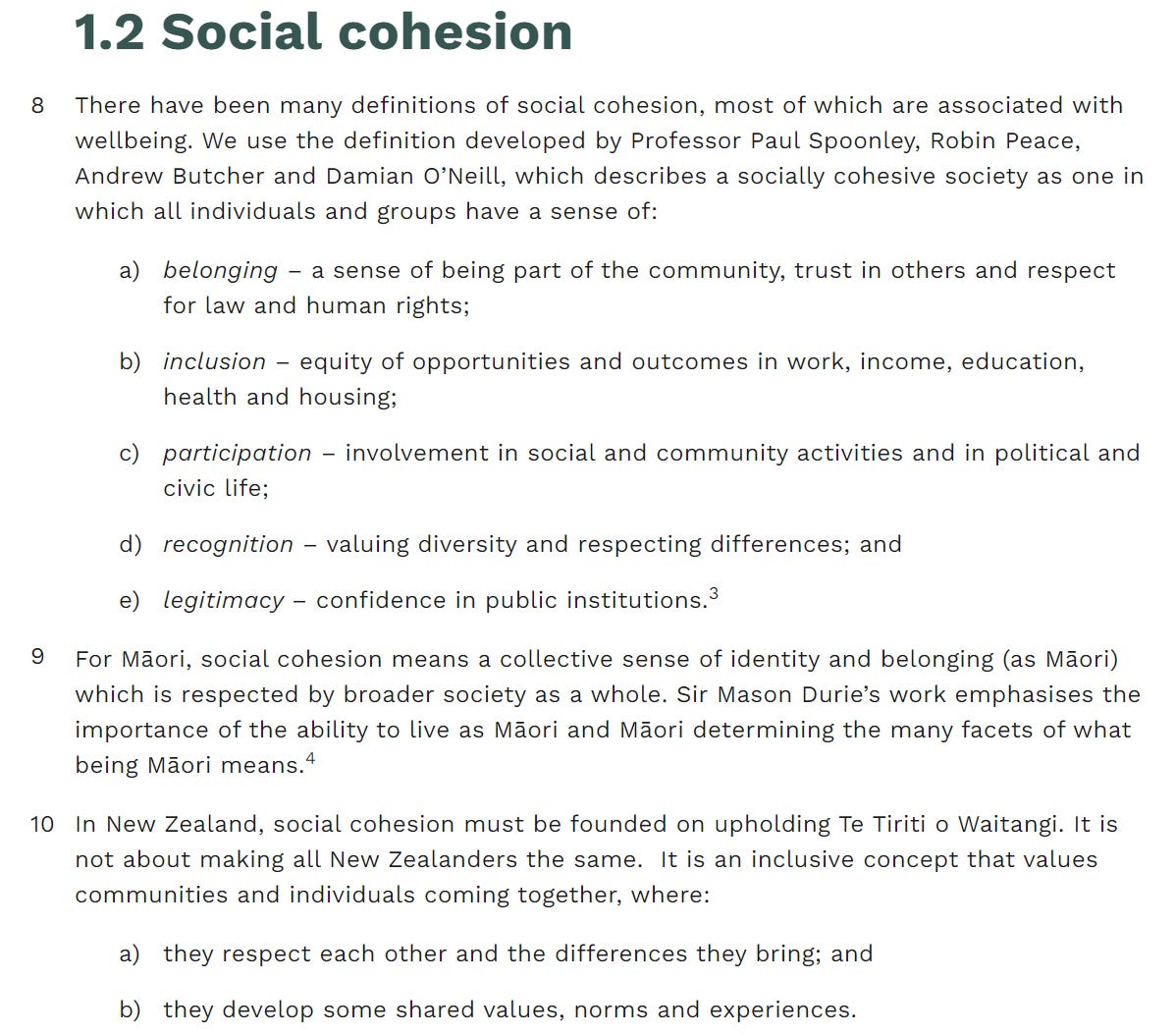Assuming that social cohesion is obviously good, is problematic
Sometimes social cohesion is chaotic and complex and reflects our individual and collective tensions. I'm fascinated by the mess.
The idea that social cohesion is not good, not always, was something I became acutely aware of when I was part of the team that developed and designed the social cohesion policy that came out of the Royal Commission of Inquiry into the March 15th attacks. I was so intrigued by the complexities of the term that I decided to do my PhD on this term, which I am currently doing and focusing on the relationship between government and social cohesion in New Zealand.
My interest in social cohesion is not in a conservative, safe, traditional view that it's obviously good and always good for everyone. I want us to have a more realistic and complex understanding of the idea, which I think will enable us to think differently about what needs to happen in order to govern a polarized society.
In this article, I will:
Share what we did in 2021-2022 to develop the Social Cohesion policy (all of this information is publicly available)
Provide a few social cohesion definitions that I found so far in my PhD journey
Then conclude with why I’m interested in the areas where social cohesion is messy, complicated, and contradictory.
1. Developing the Social Cohesion Policy in 2021
MSD was asked by Cabinet to:
Engage with communities to create a strategic framework based on a shared understanding of social cohesion that is focused on what unites us as people in New Zealand, while valuing diversity and taking tangible steps to become an inclusive society
Build on the Government’s existing work programme through tangible government actions in the short, medium, and long-term to improve social cohesion
Identify how to support and enable communities, the business sector, the cultural sector, and central and local government to undertake actions to improve social cohesion.
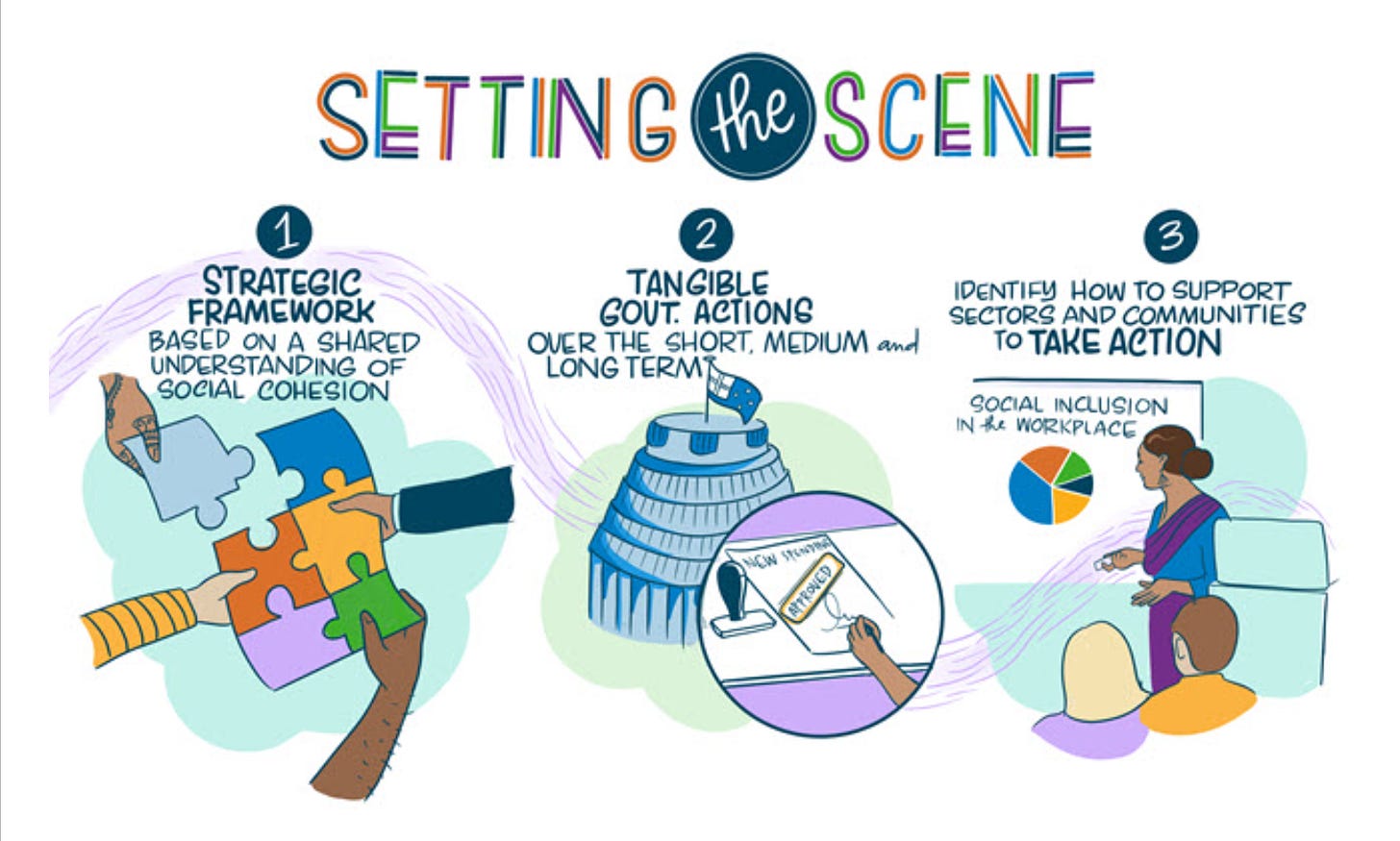
While designing and developing the social cohesion policy out of the Ministry of Social Development in 2021, we went through a robust, sophisticated 10-month engagement process and worked closely with ministers and wider government agencies.
I had the opportunity to listen to people's understandings of the idea of social cohesion for months, all around the country, from many different perspectives.
We engaged in extensive consultation with senior public servants, ministers, leaders of various community groups, residents of larger cities and regions, seniors and youth, Māori as citizens and Māori as Tangata Whenua, Pacifica and broader migrant communities, disabled communities, and Rainbow communities. Our objective was to gain a more comprehensive understanding of the form, scope, and implications of this policy for New Zealand.
Below is a snapshot of the definition of social cohesion that the Royal Commission of Inquiry into March 15 suggested.
How we engaged and why that matters
We moved as an agency from just informing the relevant communities to involving and collaborating with them, so it was a higher-level quality engagement process. The International Association for Public Participation (IAP2) spectrum provided advice on these different forms of engagement and participation in decision-making, and this spectrum was specifically identified in Recommendation 38 of the Royal Commission of Enquiry on the terrorist attack on the Christchurch Mosques report.
The idea behind this specific level of engagement was important if the government actually wants to build bridges with communities, as the social cohesion consultation material indicated. Below the IAP2 Engagement Spectrum that we sued, specially focused on the Involve level.
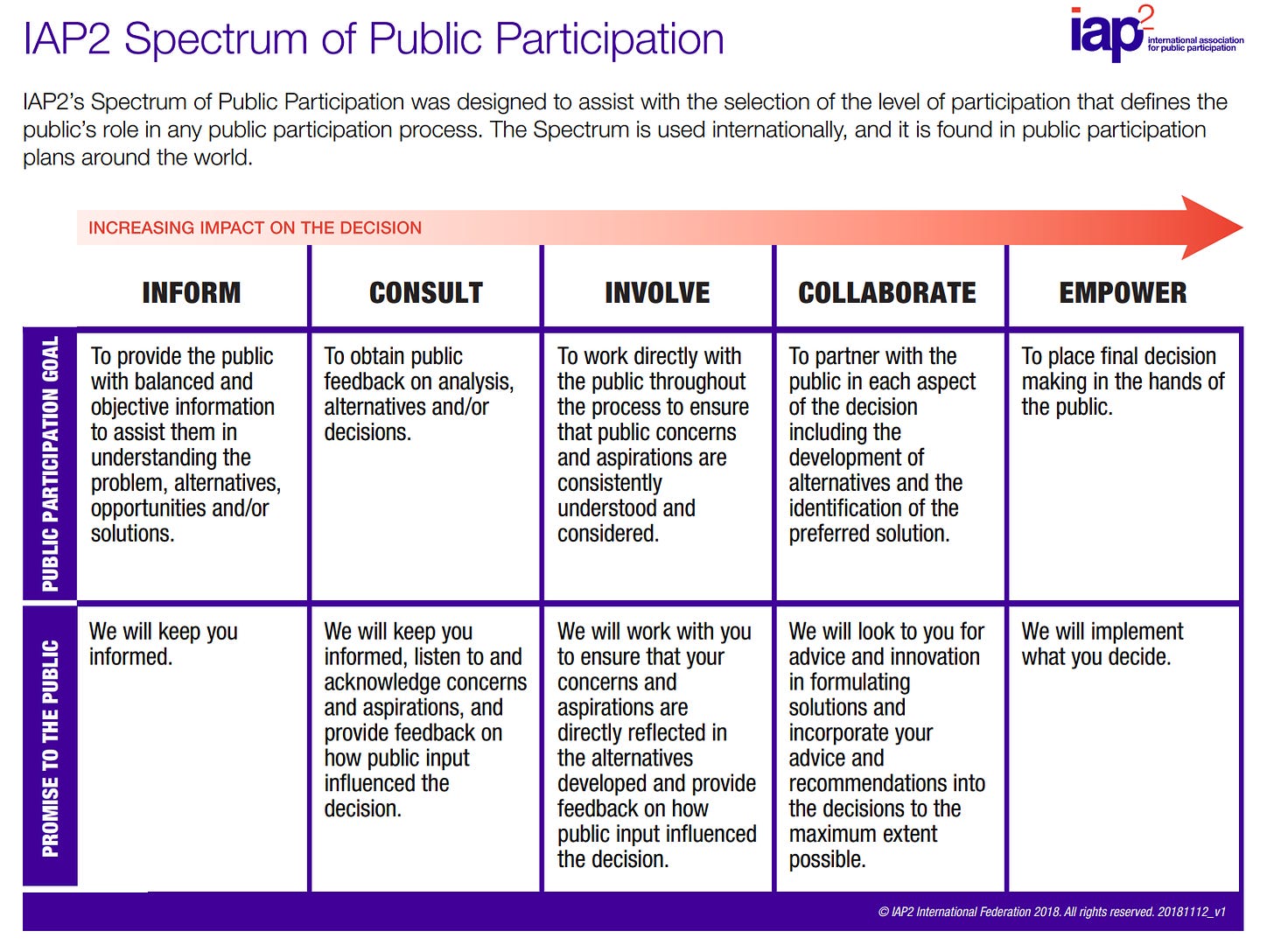
A few quotes that are published in the What we heard document published by MSD:
“Social cohesion cannot be successful if historical amnesia is maintained.”
“People and society are not a ’melting pot’ or ‘homogenised’ but instead are better viewed as a ‘mosaic’.”
“How is Te Tiriti o Waitangi embedded within the framework, beyond just ‘saying it’?”
“those who live rurally are at risk of isolation.”
“people of faith described issues such as islamophobia, and how the practice of faiths can create cohesion or exclusion”
“LGBTQIA+ people experience rejection from their families and communities”
Below is the illustration we used for our first of three two-day Wānanga at Te Papa in October 2021. We created these illustrations to diversify our communications, which was a big part of our process and something that I am very passionate about. Diversifying information is key to guaranteeing the accessibility of information, which is key to helping strengthen social cohesion.
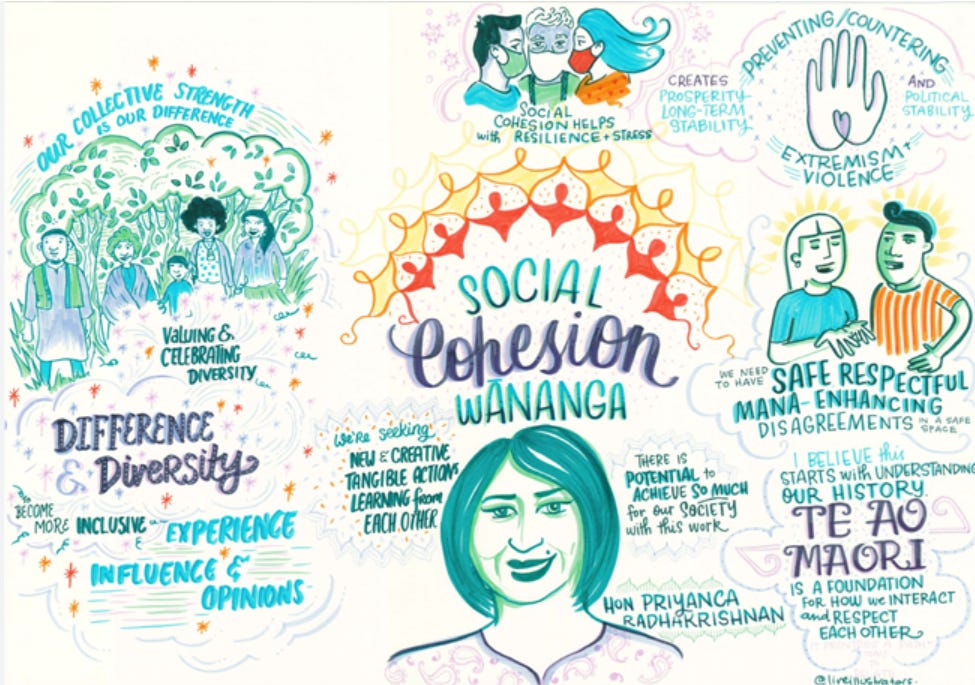
Hon. Priyanka Radhakrishnan delivered the keynote speech:
“This work is only possible with your advice and input because social cohesion starts with communities, and you know your communities better than anyone. Social cohesion is not about making all New Zealanders the same but rather valuing, celebrating, and welcoming diversity. Our diversity is our strength. Therefore, to make a real difference, we must work collectively. We need to recognise our history. Te Tiriti is the foundation on which this work must rest, and it is at the heart of our work. It is the document that enabled the diversity we have in Aotearoa today. Te Aō Māori—embedding a Māori worldview—into this work is also significant. It acknowledges relationships and interconnectedness.”
2. My take on the Social Cohesion definitions
I have an issue with the definition that was proposed by the Royal Commission of Inquiry on March 15, as well as most of the definitions I have found while doing my PhD in social cohesion.
They mainly signal a very positive, overly-simplistic, moral, and unifying value-based idea. That is at times used interchangeably with ideas of inclusion, and I think these definitions are either unfair or incomplete. I don’t think they are a good representation of what that concept means or cover what it takes to achieve it. And I think that matters.
The ground, the fire, and the conflict we must cross to get there are not spoken about or included in the definition. I think it needs to highlight the role of conflict and conflict resolution, which I think is largely left out.
Most of the definitions include outcomes of social cohesion and the effects of social cohesion, but they fail to reflect what social cohesion actually is, where and why we begin to talk about it, and the elements that build its anatomy.
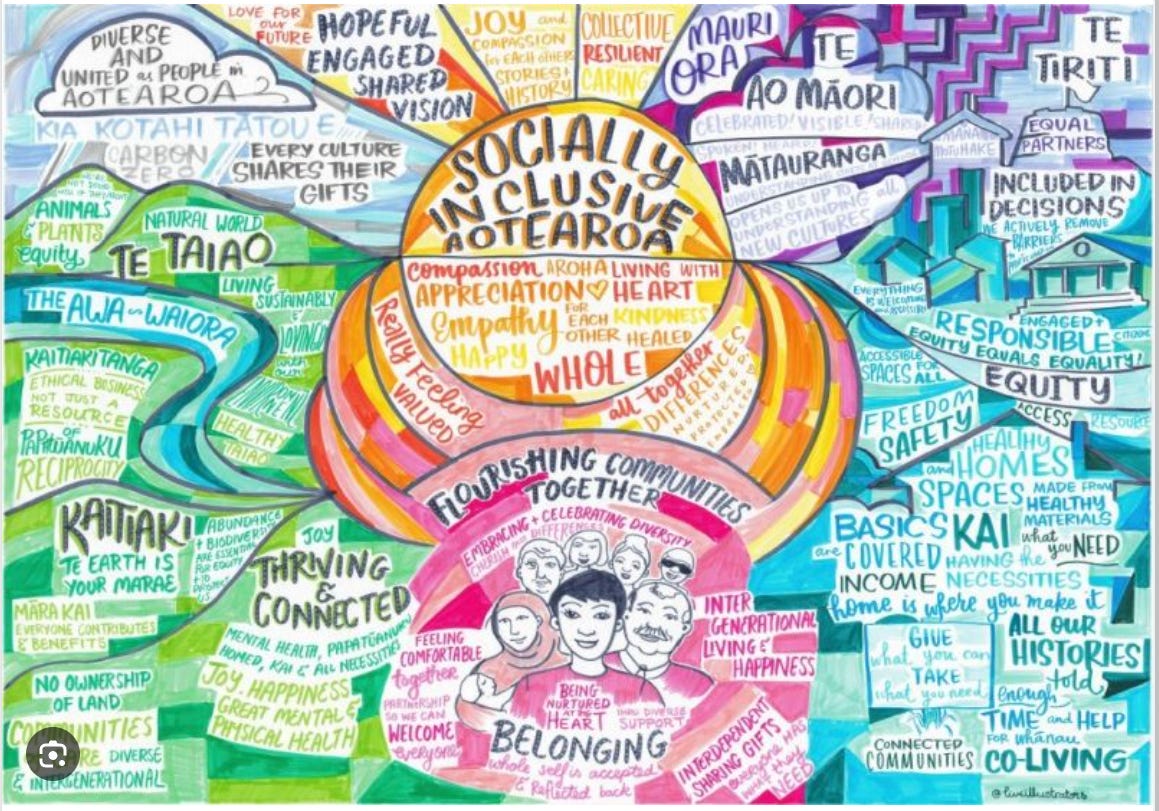
Some definitions I have found so far:
In 2020, the University of Auckland published He Oranga Hou: Social Cohesion in a Post-COVID World, written by Paul Spoonley, Peter Gluckman, Anne Bardsley, Tracey McIntosh, Rangimarie Hunia, Sarb Johal, and Richie Poulton. They defined it as:
“we define social cohesion broadly as the presence of high levels of trust, a sense of belonging, a willingness to participate and help others, and policies that ensure social and economic inclusion. This aligns with the components of social cohesion outlined in the Ministry of Social Development papers as:
• Belonging involves a sense of being part of the wider community, trust in other people, and common respect for the rule of law and for civil and human rights. New Zealand is home to many peoples, and is built on the bicultural foundation of the Treaty of Waitangi. New Zealand’s ethnic and cultural diversity should be recognised, celebrated and valued.
• Inclusion, which involves equity of opportunities and of outcomes, with regard to labour market participation, income, education, health and housing. The contribution of good settlement outcomes to social cohesion should be recognised and valued.
• Participation includes involvement in social activities, in community groups and organisations, and in political and civic life (voting or standing for election on a school board of trustees). All people should be able to participate in all aspects of New Zealand life.
• Recognition involves valuing diversity and respecting differences by all groups, including the host country, protection from discrimination and harassment, and a sense of safety. Diversity of opinions and values amongst the many cultures that make up New Zealand today should be accepted and respected.
• Legitimacy includes confidence in public institutions that act to protect rights and interests and to mediate conflicts, and institutional responsiveness. Public institutions must foster social cohesion, engender trust and be responsive to the needs of all communities.
Chan (2006) has one of the most cited definitions: A state of affairs concerning the relationship between the state and citizens (vertical), as well as the relationship among different individuals and groups (horizontal) interactions among members of society as characterized by a set of attitudes and norms that include trust, belonging, and willingness to participate and help as well as their behavioral manifestations.
Forrest and Kearns (2001, 2000) claim that Social cohesion is about getting by and getting on the more mundane level of everyday life. Its about being able to solve dilemmas and problems through collective action. A cohesive society is one that norms and trust facilitate solutions.
Schiefer and Van der Noll (2017) say that a cohesive social environment is characterized by close social relationships, pronounced emotional connectedness to the social entity, and a strong orientation towards the common good.
3. What did I learn, and why do I care about social cohesion?
What I got out of working with the Royal Commission of Inquiry into the 15 March attacks and MSD on the social cohesion policy, besides a deep passion to understand this idea further, was that the crux of social cohesion is the tension between these groups, the potential for conflict, and the idea of avoiding violence and social conflict resolution.
After this transformational professional and personal experience, I started to care deeply about how we could co-exist with each other and our differences. I don't care for us to have shared values; I don't believe we do.
I don't believe we can avoid or come back from the polarised ideologues, so how do we move forward? How do we govern a polarised society? This is what I am interested in. I'm not interested in a romantic, performative notion of social cohesion, but a complex, messy, and contradictory one.
I want to understand the side of social cohesion that is not spoken about—the controversial side of it. Where the tensions rub against each other—where religion rubs with the state, where the individual rubs with the collective, where responsibility rubs with freedom, where accountability rubs with authority, where modernity rubs with colonisation.
What questions should we be asking?
Can you dissent/disagree with the majority view without being criminalised or punished, formally or informally?
Can you disagree safely?
Who can disagree safely?
What are we needing to do too?
Who needs to cohere to what?
Who decides who is socially cohesive and who is not?
Who decides who's not being cohesive?
What are the criteria to establish that something is or isn't cohesive?
What needs to be done by you individually?
What needs to be done by the media?
What do community leaders need to do?
What needs to be done at the neighbourhood level?
What's the responsibility of the collective versus the responsibility of the individual?
What’s the role of the law and the justice system?
How far should legal coercion go in order to achieve social cohesion?
I want to inspire people to think about social cohesion in a way that highlights the tensions, the contradictions, where we rub, where there is potential for conflict, and what the scale of the conflict is.
None of these questions are easy to answer, which is why I'm interested in social cohesion. I don't want to study it or specialise in this area to be one more voice using social cohesion as propaganda for people to behave, shut up, and do as they're told. Or, even worse, say it to give the impression that I am actually doing something about it, when I am not.
I want to understand social cohesion because I want us to be able to cope with the differences between us in a way that doesn't jeopardise our individual safety, our community safety, or our national safety. Which I think it has the potential to do unless we commit to a more realistic, messier version of this term.
So social cohesion and thinking initially that it's problematic are where I think we need to start when we're talking about it. Thoughts?
See you next Tuesday!




